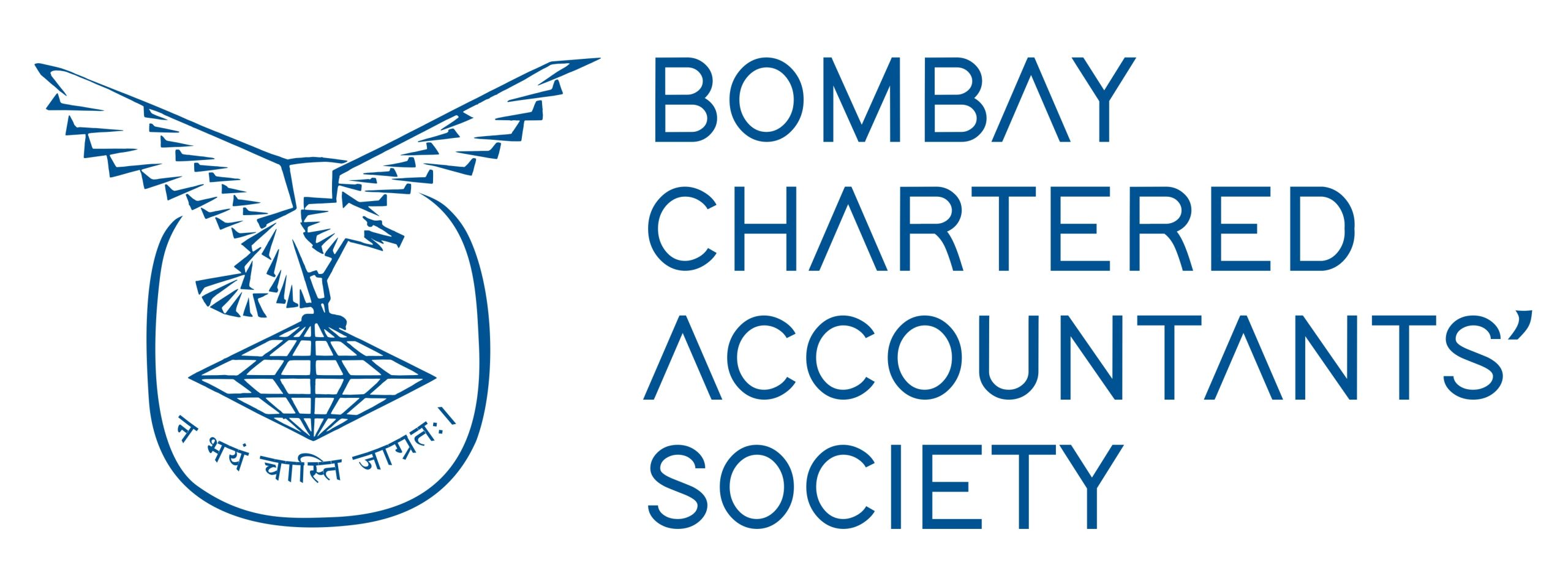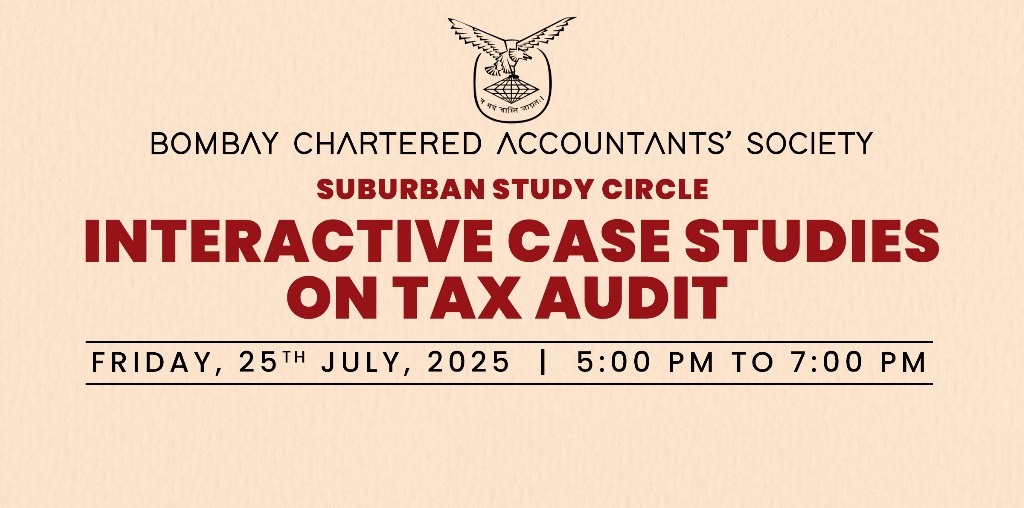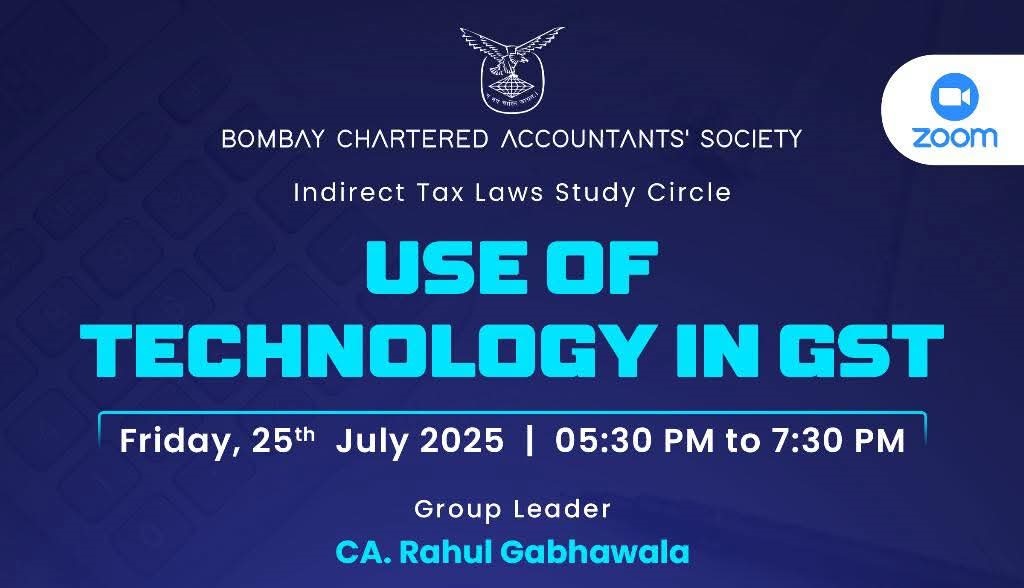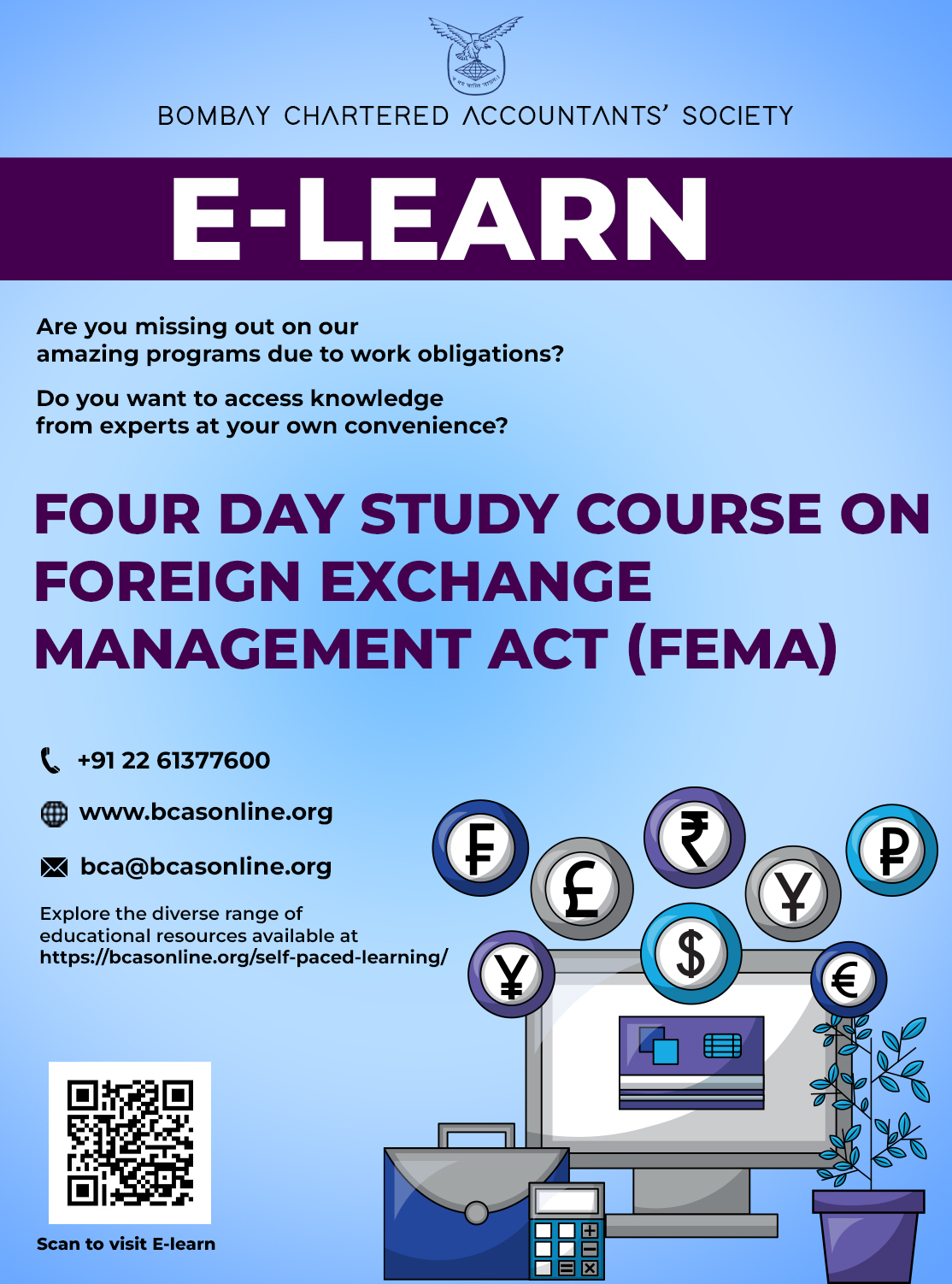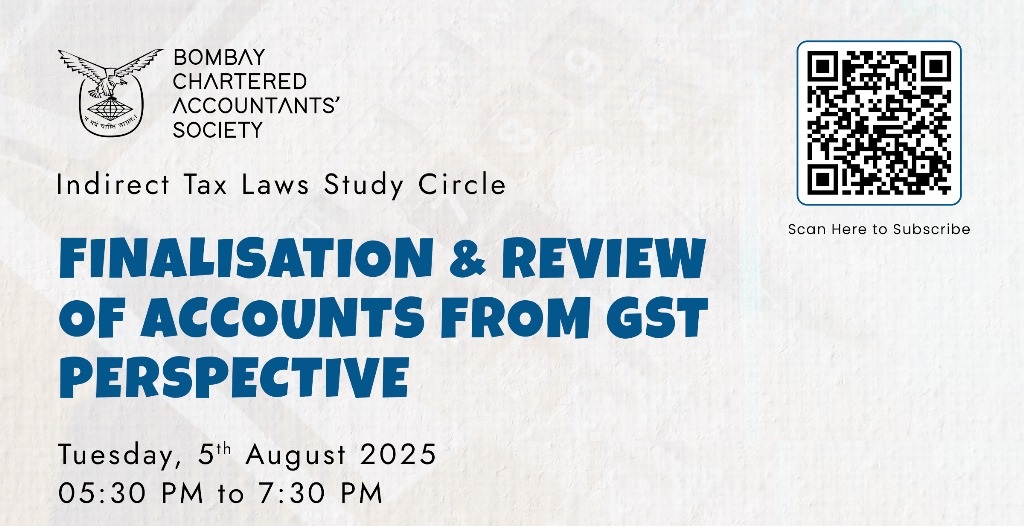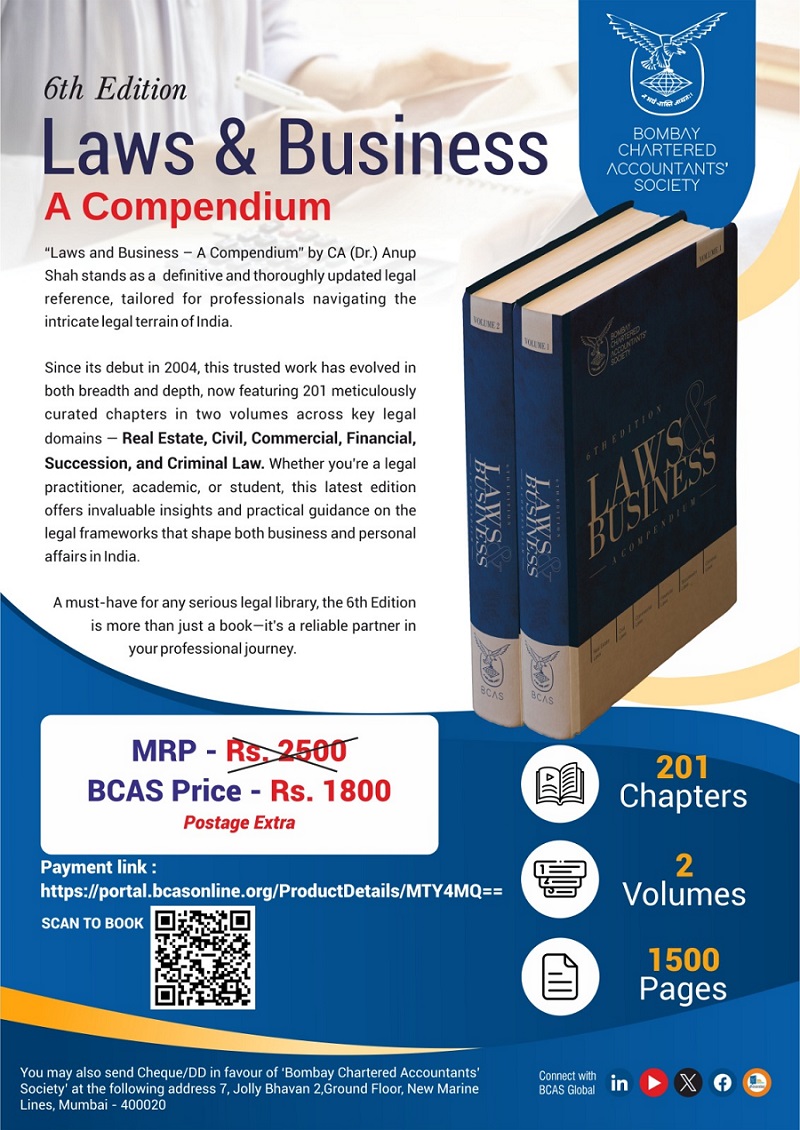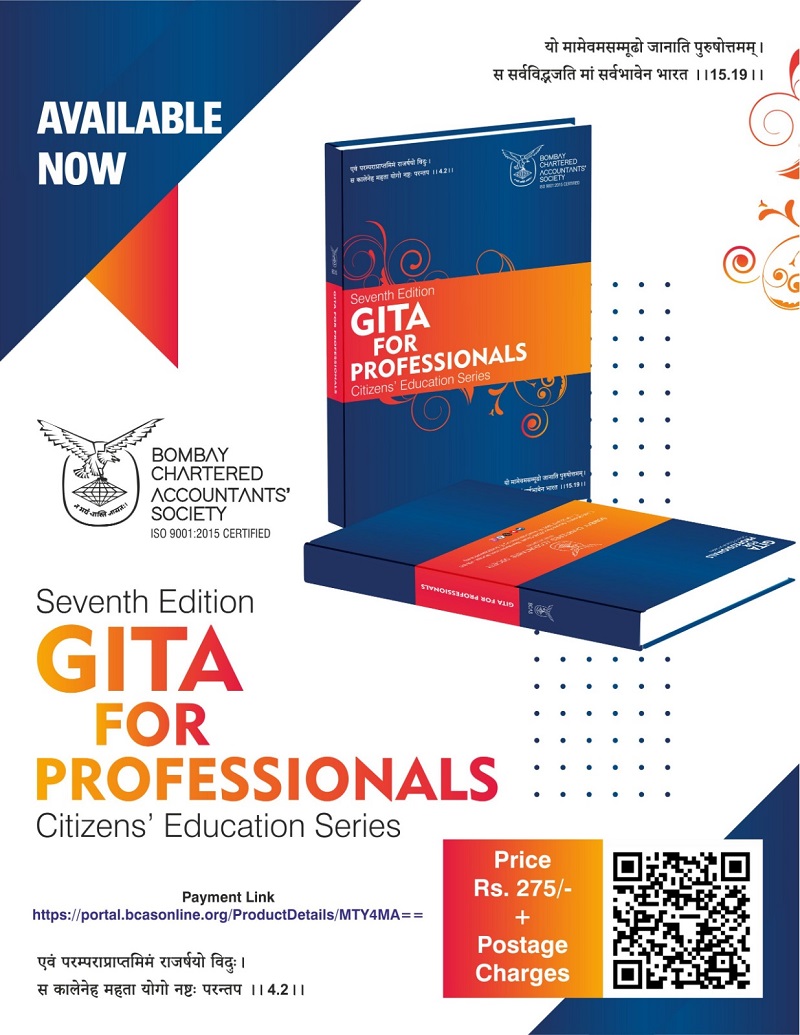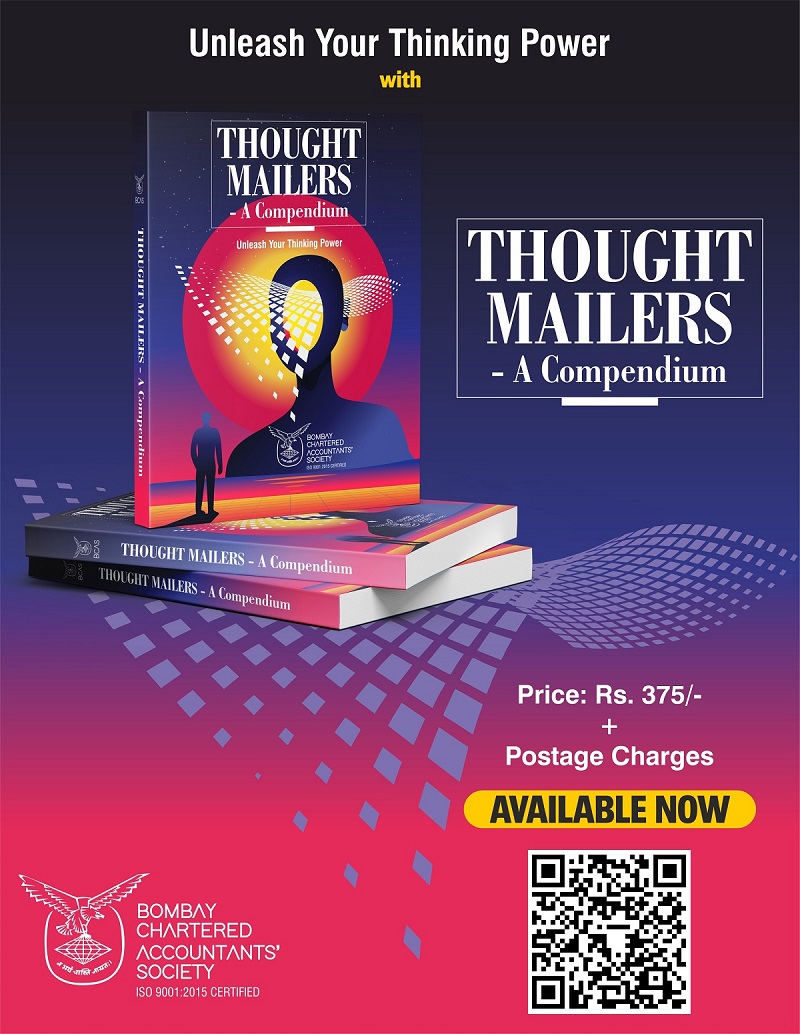Society News for month of September 2022
Details:
DIRECT TAX LAWS STUDY CIRCLE MEETING ON ‘INTERPLAY BETWEEN INCOME-TAX ACT, 1961 AND INSOLVENCY AND BANKRUPTCY CODE, 2016’ ON 21ST JULY, 2022
The Group leader, CA Priyanka Jain, took the group through the objective and preamble of the Insolvency and Bankruptcy Code, 2016 (IBC). The interplay between the legal provisions under the Income-tax Act, 1961 and IBC was discussed in detail. Further, judicial precedents relating to the moratorium period, resolution plan and liquidation were discussed.
After that, the group leader discussed the open issues relating to section 56(2)(viib) of the Income Tax Act, 1961 and section 281.
LECTURE MEETING ON UNSEEN CONNECTION BETWEEN UKRAINE WAR & DIGITAL TAXATION
BCAS had organized a hybrid lecture meeting on “Unseen Connection between Ukraine War & Digital Taxation” by CA Rashmin Sanghvi.
The Managing Committee, along with the Economic Study Group, organized the event on 1st August, 2022.
Key takeaways of the talk:
1. USSR Afghan War & Reagan Plan
USSR Afghan War and Reagan Plan use others to achieve your targets without losing your soldiers. A combination of Economic War + Supply of weapons to enemy of enemy works.
|
Year
|
Events
|
|
1975
|
The USA is ruled by Think Tank on several subjects.
By 1950, USSR emerged as superpower number 2 (the USA being no.1).
Europe was facing the heat of World War, and other countries were still
referred to as British Colonies who just got Independent and were busy
putting their home affair in place.
|
|
1975
|
So, there was a cold war between USSR and US from 1950 to 1975. By
1975, the USA understood they could not fight a war with an equal or
almost equal opponent. Thereby, a military war of fighting with the
USSR was ruled out.
|
|
1979
|
USSR (Union of Soviet Socialist Republics) was a landlocked country in
1975 with huge mineral resources. USSR desired entry into the Indian
Ocean to grow its trade and global presence. So, they decided to invade
Afghanistan (Geopolitics), followed by entry into Iran and Pakistan.
From the Indian Ocean, Russia can reach European and African Markets.
|
|
1979- 1985
|
By nature, Afghan people are patriotic and fighters. So, the Afghan
people implemented Guerilla warfare techniques to fight the Russian
Invasion. Afghanistan derived support from the USA through arms,
ammunition, and financial support. Thereby, Afghan tribals began to
fight against USSR.
For the USA to support Afghan, they needed a land base for Helicopters;
since the USA had strained relations with Iran, they approached
Pakistan, and all weapons and ammunitions flowed from the USA through
Pakistan into Afghanistan during 1983 – 1985.
|
|
1983
|
US President Reagan: Russia cannot be defeated politically or
militarily. Hence, in 1983, he approved the plan for Economic War on
USSR. The plan was prepared by US Think Tank much before Reagan became
President.
The USSR was a Socialist Economy, and the prices of essential products
remained the same since 1914. As a result, Economics was an unknown
subject for Russians in power.
Soon, the global economy was Dollarized. All international trade,
speculation, money lending, everything happens in dollars. As a result,
all the countries must hold the Dollar as a reserve. The USA could
borrow from the world because of the Dollarization. But the USSR could
not borrow. This was the beginning of the Economic War, and USA started
financing the war in Afghanistan. The USA had enough reserves to fund
the war till 1989.
During his tenure, Regan announced the Strategic Defense Initiative
(SDI), nicknamed the “Star Wars program”,
GPS and computer-guided missile defence system with nuclear warheads
intended to protect the United States
from attack.
|
|
1985
|
Mikhail Gorbachev became Prime Minister in 1985 and soon realized that
USSR reserves were depleted; further, nobody outside the US would hold
Ruble. On the other hand, US Dollar was owned across the world and was
gaining power
|
|
1985
|
over Russian Ruble.
Further, USSR had made a large investment in building a missile defence
system.
Knowing that USSR was building a weapon to counter
Star Wars missiles, the US developed the Anti-Missile Missile, which
means a missile will strike another missile in the air, and a nuclear
warhead will fall in the sea, and the land area of the home country is
not destroyed and damaged.
|
|
1989
|
So, USSR accepted defeat in Afghanistan and withdrew its army.
Both USSR and USA realized that researching, developing and
manufacturing missiles is a costly affair, so they entered into a treaty
to stop manufacturing missiles. President Regan ordered to ignore this
treaty, and that the USA would continue its R&D on the missile.
But, by then, these Star Wars – Arms Race had Forced USSR into poverty
|
|
1991
|
USSR crisis begins and it withdrew its army from East Europe.
USA, Britain, France, and Germany (Great Four or G4) decided that they
would not buy anything from USSR. On the other hand, USSR was dependent
on other countries for its daily essentials – milk, bread, fish, etc. G4
announced they would sell to USSR only for cash. This forced the USSR
into insolvency.
|
|
1992
|
East European countries start declaring independence.
USSR breaks into 15 countries – Armenia, Azerbaijan, Belarus, Estonia,
Georgia, Kazakhstan, Kyrgyzstan, Latvia, Lithuania, Moldova, Tajikistan,
Turkmenistan, Ukraine, Uzbekistan, and Russia.
USA won the ECONOMIC WAR.
|
|
1991-1993
|
Boris Yeltsin became Prime Minister in 1991 with absolutely no knowledge
of economics. G4 agreed to support Russia provided it agreed to become a
Capitalist Country. Once Yeltsin agreed to the terms of G4, considering
the dire situation at home, G4 backed out from providing financial
support.
|
|
|
Financial Impact on Ruble
|
Year
|
Ruble per USD
|
|
Jan 1990
|
4
|
|
1992
|
100
|
|
1997
|
31,500
|
|
1998
|
31.5 (1000 Ruble were converted into 1 Ruble)
|
|
Feb 2022
|
101
|
|
Jul 2022
|
57
|
This currency depreciation meant that the USSR went insolvent.
|
The Afghan War led to the disintegration of the USSR, and now only USA was the superpower.
2. Digital Taxation
Base Erosion and Profit Shifting (BEPS) is formed so that the tax planning strategies used by multinational enterprises do not exploit gaps and mismatches in tax rules to avoid paying tax. It is said: that BEPS reports on Digital Taxation have been mainly drafted by US Digital Corporations. They are extremely complicated for the taxpayer to comply with and the tax officer to administer.
BEPS Group for Digital Taxation could not come to any conclusion from 2013 to 2019. Probably because the USA would not agree to any sharing of tax revenue. Finally, in 2019, the OECD Secretariat published the report bypassing BEPS Group.
3. Ukraine Russia War & US Plan
A hypothesis to ponder upon:
- Is Ukraine the current camel being used by the USA to further damage Russia?
- Is the fear of Russia used to keep Europe under NATO/US influence?
The USA has established Bio Laboratories in Ukraine, intending to use these weapons against Russia in case of War. These Laboratories were technically and functionally financed by the USA.
NATO’s invitation to neighbouring countries to join the group was a clear indication of irritation to Russia. When Russia declared war on Ukraine, Germany said they would not start an exclusive gas line built from Russia to Germany by the Russian Government. This was a major setback for Russia.
The response of Russia is a response to the Economic War against the US. Russia cut Gas supplies to Europe and insisted on payments in Ruble or gold. In this crisis, USA and EU cannot ride out the crisis by increasing the money supply and interest rates. People need gas and food, not illusions.
Crises in Europe
- US attacked Iraq and imposed sanctions on Iran. Iran and Iraq were selling oil in Euro. The war led to a fall in oil sales from Iran/Iraq to Europe, leading to a weakening Dollar and a strengthening Euro. Yet, Europe joined the US in weapons/Economic wars against Iraq & Iran.
- US used Ukraine to fight Russia, which reduced the energy supply to Europe. As a result, Europe is facing a severe recession.
PhilosophyUnilateralism = Ego + Greed + Desire to Rule & Exploit othersOn a global macro level – Powerful nations/ companies and individuals will try some strategies to rule and exploit others.Earlier, Europe ruled the world & exploited the world. Russia & China have also acted similarly. It is important for India to remain independent.
Youth, wealth, power and indiscretion any one of these can cause destruction. Abuse of power harms the victims. However, it harms the Abuser even more than the Victim.
CA Rashmin Sanghvi answered all the questions raised by the participants present physically as well as raised on the chat and Q&A box.
YouTube Link:
https://www.youtube.com/watch?v=WzSPjJawGK4
REPORT ON THE MEETING OF THE HUMAN RESOURCE COMMITTEE
On 5th August, 2022, the Human Resource Committee of Bombay Chartered Accountants’ Society organized a talk by Shri Kaivalya Smart on The Life sketch of Shri Aurobindo. This was to commemorate the 150th Birth Anniversary of Shri Aurobindo coinciding with the 75th Anniversary of India’s Independence from British Rule. Important highlights of the presentation were:
Childhood and education
Shri Aurobindo was born in Calcutta on 15th August, 1872. In the early days, he studied in Darjeeling. In 1879, at the age of seven, his two elder brothers was taken to England for education and lived there for fourteen years. Brought up at first with an English family in Manchester, he joined St. Paul’s School in London in 1884 and in 1890 went with a senior classical scholarship to King’s College, Cambridge, where he studied for two years. In 1890, he also passed the open competition for the Indian Civil Service, but at the end of two years of probation failed to present himself at the riding examination and was disqualified from service.
In India
At that time, the Maharaja Gaekwad of Baroda was in London. Sri Aurobindo saw him, sought an appointment in the Baroda Service and left England for India, arriving there in February 1893.
Sri Aurobindo stayed for thirteen years, from 1893 to 1906, in the Baroda Service, first in the Revenue Department and in secretariat work for the Maharaja, and later on as Professor of English and, finally, as Vice-Principal in the Baroda College. He developed an interest in literary activities. The poetry, much later published from Pondicherry, was composed at Baroda.
At Baroda, he learnt India’s culture, Sanskrit and several modern Indian languages. He had command over many European languages. He spent his time in silent political activity since he was not granted public action due to his position at Baroda.
Political and public life
The outbreak of the agitation against the partition of Bengal in 1905 allowed him to give up the Baroda Service and join the political movement. He left Baroda in 1906 and went to Calcutta as Principal of the newly-founded Bengal National College.
The political action of Sri Aurobindo spanned eight years, from 1902 to 1910. During the first half of this period, he worked behind the scenes, preparing with other co-workers for the Swadeshi (Indian Sinn Fein) movement, and was part of the Indian National Congress. In 1906, Sri Aurobindo came to Bengal with this purpose and joined the New Party, which had been recently formed in the Congress. Sri Aurobindo persuaded its chiefs in Bengal to come forward publicly as an All-India party with a definite and challenging programme that changed the face of Indian politics in two years.
The newborn Nationalist party put forward Swaraj. Boycott of British and foreign goods and the fostering of Swadeshi industries to replace them, the boycott of British law courts, universities and colleges and the creation of a network of National colleges and schools, the formation of societies of young men to do the work of police and pursue a policy of passive resistance.
Sri Aurobindo founded the daily paper Bande Mataram, as an acting editor. The Bande Mataram continued till its abrupt winding up in 1908 when Sri Aurobindo was imprisoned.
Sri Aurobindo was prosecuted for sedition in 1907 and later acquitted. He was arrested in the Alipore Conspiracy. He published a weekly English paper, the Karmayogin, and a Bengali weekly, the Dharma. During his twelve months’ detention in the Alipore Jail, spent entirely in yoga practice, his inner spiritual was unfolding for an exclusive concentration. He had glimpses of divine intervention.
Pondicherry
In April 2010, he sailed to Pondicherry French colony in India, leaving Bengal. The spiritual work needed exclusive concentration of all his energies. Eventually, he cut off connection with politics, refused to accept the Presidentship of the National Congress and retired.
During his stay at Pondicherry from 1910 onward, he remained exclusively devoted to his spiritual work and sadhana.
In 1914, after four years of silent Yoga, he published a philosophical monthly, the Arya. His more important works, The Life Divine, The Synthesis of Yoga, Essays on the Gita, and The Isha Upanishad, appeared serially in the Arya. These works embodied much of the inner knowledge that had come to him in his yoga practice. These were concerned with the spirit and significance of Indian civilization and culture (The Foundations of Indian Culture), the true meaning of the Vedas (The Secret of the Veda), the progress of human Society (The Human Cycle), the nature and evolution of poetry (The Future Poetry) and the possibility of the unification of the human race (The Ideal of Human Unity). At this time, he had also begun to publish his poems written in England and those composed at Baroda. The Arya, after six and half years of uninterrupted publication, in 1921, stopped publication. Sri Aurobindo lived in retirement at Pondicherry with four or five disciples. Later on few more. The numbers grew so large that a community of sadhaks had to be inspired by the guidance of those who had left everything behind for a higher life. This was the foundation of the Sri Aurobindo Ashram.
Though, Sri Aurobindo began his practice of Yoga in 1904. He was initially gathering the essential elements of spiritual experience and a further quest for a more complete experience uniting and harmonising the two ends of existence, Spirit and Matter. Supramental Force for the transformation of mind and body. To realize has been the dynamic aim of Sri Aurobindo’s Yoga.
Sri Aurobindo left his body on 5th December, 1950.
The Mother carried on his work until 17th November, 1973.
SYNOPSIS OF LECTURE MEETING ON “UNILATERAL, BILATERAL AND MULTILATERAL SOLUTIONS FOR DIGITAL ECONOMY CHALLENGES
On 17th August, 2022, the Society organised a virtual lecture meeting on the topic “Unilateral, Bilateral and Multilateral solutions for digital economy challenges” by CA Radhakishan Rawal.
CA Rawal shares his deep knowledge on the subject through an engaging talk alongwith live polls on the digital platform.
The speaker explained that many business models today are running globally without any physical presence. Technology has moved too far, but the tax laws did not. So, the countries are facing challenges relating to the taxation of Digital Services without any physical presence. In relation to such digital services, he gave an overview of new tax laws already adopted alongwith proposed tax laws which may be implemented in the coming future. Below is the snapshot of his address:
Unilateral Solution – This is the trade agreement wherein one country imposes restrictions on another and is not reciprocated.
- Twenty seven countries have enacted Digital Services Tax (“DST”) or similar measures.
- Fifteen countries have announced or proposed similar tax policies.
- Rates range from 1.5% to 7.5%.
Difficulties in Unilateral solution
- Complexities related to interpretation, understanding, manner of new provisions. (e.g., Levy of Equalization Levy @2%).
- Approach of Tax Authorities is not to give up on any revenue.
- The biggest issue is the credit for taxes paid in the home country of e-commerce operator (i.e. the entity which is earning the income) and if this is seen as a levy outside of the tax treaty, then the home country does not have obligation to give treaty benefit, which may lead to double taxation.
- Question over availability of Tax treaty benefit? (Section 90).
- Unilateral measures are found to be discriminatory in nature.
Bilateral Solution – These kind of trade deals benefits both parties to maintain economic stability. It can be signed in various areas such as double taxation agreement, tariff, custom clearance etc. Both countries have extended their hands to have access to each other’s market.
U N Solution – Article 12B: Article 12B was implemented in record time. It has reduced the complexities involved in DSTs & tried to make it simple. It has introduced the term “automated digital services”. An option is available for the taxpayer to pay taxes either on “gross basis” or “net basis” and (30% of qualified profit., qualified profit means relevant revenue * profitability ratio).
Difficulties in Bilateral solution
- It is not a consensus solution among multiple countries.
- Absence of mechanism to quickly implement Article 12B in tax treaties.
- There is need for UN MLI as like BEPS MLI to see the practical uses of Article 12B.
- Lack of incentives for countries to sign the bilateral tax treaty.
- Initiation of work by UN tax committee.
Multilateral Solution – Here, there exists three or more parties in a trade agreement. The main aim is to reduce the tariff to boost imports and exports. OECD has worked upon Pillar 1 as a solution to tax the digital economy.
Difficulties in Multilateral solution
- Challenge in Fair allocation of taxing rights.
- Time consuming approach with many moving parts.
- Whether the USA will accept it? – Challenges in US Senate.
- 2/3rd majority in Senate would be required to pass this law in US.
YouTube Link:
https://www.youtube.com/watch?v=DVuFRWOYajw




